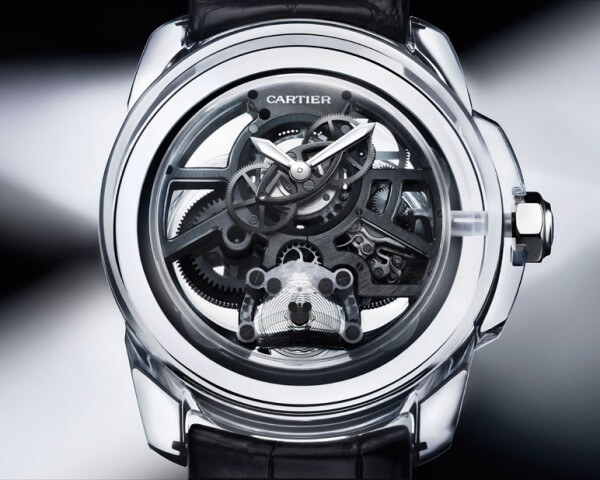When Cartier has a vision it’s wise to take it seriously, given the scale of resources the Maison has available. If you want an example, just look at its entry into the world of Fine Watchmaking. In not much more than four years, Cartier has delivered 15 internally produced calibres including the 1904 MC, the basic Manufacture movement, all of them with a consistency and a unity of style that is quite remarkable. And, as if that were not enough, it has also explored other avenues with leading-edge research that draws timekeeping inescapably towards the future. The first real demonstration came in 2009 with the unveiling of the ID One, the Manufacture’s first concept watch that requires no adjustment and no lubrication.
Vision of the future
Today Cartier has pushed back the boundaries even further with its ID Two. The second development of this kind and a descendent of the first, it fundamentally re-examines the performance of a watch calibre. “These concept watches are not some kind of marketing initiative,” said the CEO of Cartier International, Bernard Fornas, during a day dedicated to the ID Two. “The innovations they incorporate will have a real influence on the movements we produce in the future, in terms of quality, reliability and durability. In other words, our aim is to produce a commercial series of watches that have the properties we can create in research & development today. Thanks to the spirit of innovation that is so strong at Cartier, we are already relatively well positioned with a level of returns under guarantee of less than 5%. This is exactly the direction in which we are focusing our efforts.”
To put it simply, Cartier’s concept watches represent the Maison’s vision of watchmaking in the future. And this inescapably means addressing the problem of efficiency since a traditional mechanical movement loses something like 75% of its energy between the barrel and the balance. Solving this problem would open up the possibility of reducing the size of a mechanism, or putting more energy-greedy functions into the same space, while improving the timekeeping. For Cartier, the equation consists of storing more energy and reducing its consumption in the transmission chain and the regulating organ. Cartier is taking it step by step, starting with the barrel then analysing the gear train and the escapement before returning again to the balance.

A compendium of innovations
First innovation: the barrel spring. Because it is normally made in a metal that has clear physical limitations as well as problems with friction, the barrel spring has been the subject of intense research. In looking at new materials that may be capable of storing additional energy, Cartier has opted for fibreglass coated in Parylene, which makes lubrication unnecessary. This new material has been calculated so that its thinness reduces its size, allowing two springs to be superimposed in both connected barrels of the watch. As a result, the ID Two stores 30% more energy in a standard volume. Second innovation: the gear train. Here Cartier has chosen an epicyclic, or “planetary”, solution with a high transmission ratio. And the silicon gears, with redesigned teeth, are coated in carbon crystal which has a very low coefficient of friction. What’s more, these components are produced by engraving with the DRIE (Deep Reactive Ion Etching) process which delivers a degree of precision that significantly reduces the amount of play between the gears. As for the escapement, the solution developed for the ID One has been retained as it fits perfectly into this search for efficiency.
All that remains is the spiral balance, the most energy-hungry organ in the watch due to friction and air-resistance. Here again, carbon crystal offers the start of a solution with an ADLC-coated titanium shaft. But Cartier is not content with half-measures. Taking its analysis to its logical conclusion, it has removed the air from the entire watch case to allow increased amplitude for the balance. Of course, this brilliant idea creates an industrial headache since existing seals are only designed to resist water, not air. But never mind, it’s just another challenge that Cartier is ready to take on.
First results on the market
Cartier has started work on developing new seals, coated in nanoparticles, that show the properties required. Now it has to minimize the contact surfaces between the different parts of the case in order to reduce the number of seals. A new breakthrough is the development of a transparent polycrystalline ceramic, a first in watchmaking. Since the ceramic can be moulded, the case middle and the glass are a single unit. Only the case back is added and this requires no screws since it is held in place by the vacuum in the case. The final result is truly astonishing: 30% more energy stored and energy consumption cut in half, giving this 4 Hz movement a power reserve of 32 days! Cartier has applied for 6 patents on the ID Two.
As Bernard Fornas explained, Cartier concept watches are far more than an exercise in style. The research carried out for the ID One has led directly to the creation of the Rotonde de Cartier Astrotourbillon carbon crystal, the first watch to incorporate the breakthroughs of a movement that needs no adjustment or lubrication. Conclusion: “The Rotonde de Cartier Astrotourbillon carbon crystal, produced in a limited and numbered edition of 50 pieces, opens a new page in the history of Cartier watchmaking.”




















